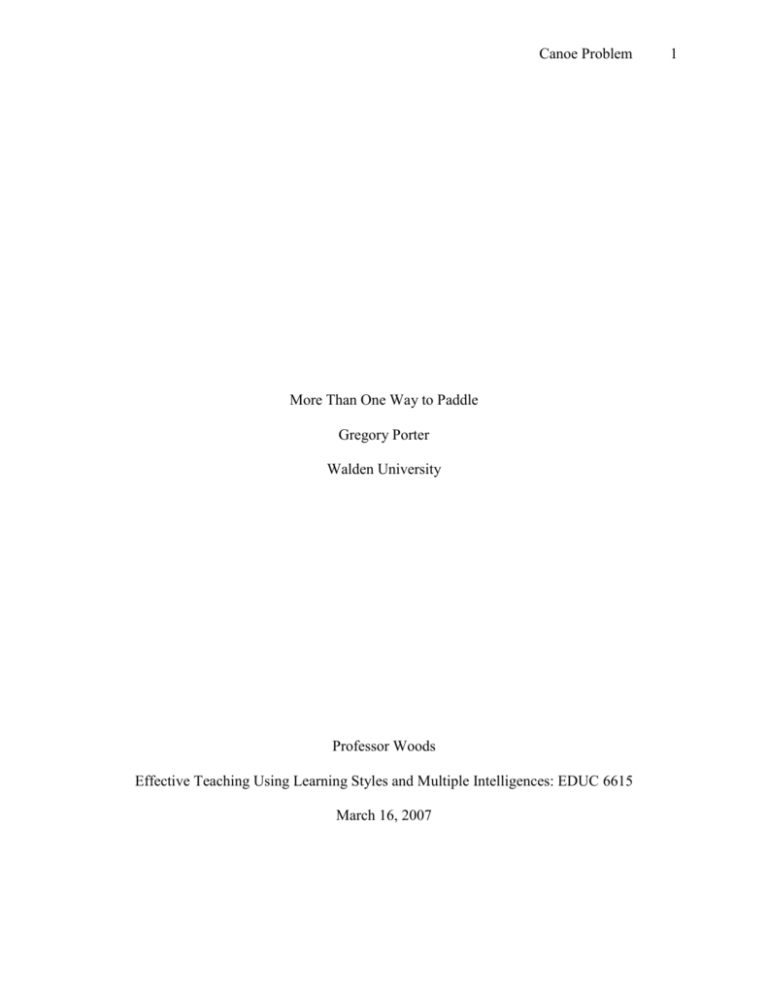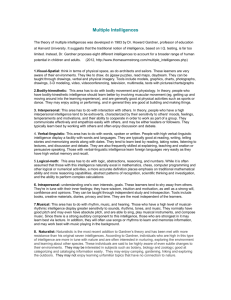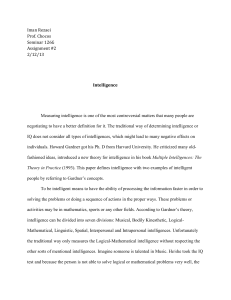Walden University
advertisement

Canoe Problem More Than One Way to Paddle Gregory Porter Walden University Professor Woods Effective Teaching Using Learning Styles and Multiple Intelligences: EDUC 6615 March 16, 2007 1 Canoe Problem 2 MORE THAN ONE WAY TO PADDLE To solve the canoe problem (Silver, Strong, and Perini, 2000), I primarily used Spatial and Interpersonal Intelligences, my dominant traits, according to Howard Gardner’s Eight Intelligences (Silver, Strong, & Perini, 2006). I also used less prevailing intellects such as Logical-Mathematical, Verbal-Linguistic, and Interpersonal respectively. Using my Spatial Intelligence, I first approached the problem by visualizing the fastmoving river surrounded by a forest of trees where the silent canoe rested rhythmically among the laps of water washing up on the bank. Pondering their dilemma, the bewildered students stood behind the patient teacher engaged in deep thought as her hand stroked her chin. Thinking through the problem in my head, I talked it out as I wondered if a one-way trip or round-trip would equal one trip according to the author of the problem. This method utilized my Intrapersonal Intelligence as thinking it through and talking aloud are traits of that particular intelligence. Using my Verbal-Linguistic Intelligence, I reread the challenge several times (out loud, of course) to solidify my comprehension of the circumstance. I attacked the problem by using numbers and operations to shape a formula that engaged my Logical-Mathematical Intelligence. I originally set out to draw a diagram that would have executed my dominant Spatial Intelligence but opted to write a formula after securing the image in my head. To create the formula, I assumed that the author defined a trip as one-way journey across the river. Since only three people could fit in a canoe, and the teacher had to accompany students on every trip, I calculated that only two students could cross the river at one time. Every two students would constitute two trips, as a round-trip would be required to pick other children up. Canoe Problem 3 The exception to the formula was the last expedition since a round-trip would not be required on the final jaunt. My Spatial Intelligence dominated this challenge. I started out with a vision of the problem and even created a diagram in my head. My Musical and Bodily-Kinesthetic Intelligences were quickly discarded throughout the process. Since I had the vision, I had no need to act it out or put it to rhythm. I may have used a bit of Naturalist Intelligence in thinking about the river current and perhaps some boulders to maneuver, however these were abstract thoughts used to construct the imagery and were not included in the concrete operation. Even as I crunched the numbers on paper using my Logical-Mathematical Intelligence, I envisioned the whole process in my mind “watching it” unfold before my eyes. Thus, my dominant intelligence subjugated the assessment throughout the entire process. Canoe Problem References Silver, H. F., Strong, R. W., & Perini, M. J. (2000). So each may learn: Integrating learning styles and multiple intelligences. Alexandria, VA: Association for Supervision and Curriculum Development. Silver H.F., Strong R.W., & Perini M.J. 2006. Learning Style/Multiple Intelligences Checklist. Ho-Ho-Kus, NJ: Thoughtful Education Press, LLC. 4




